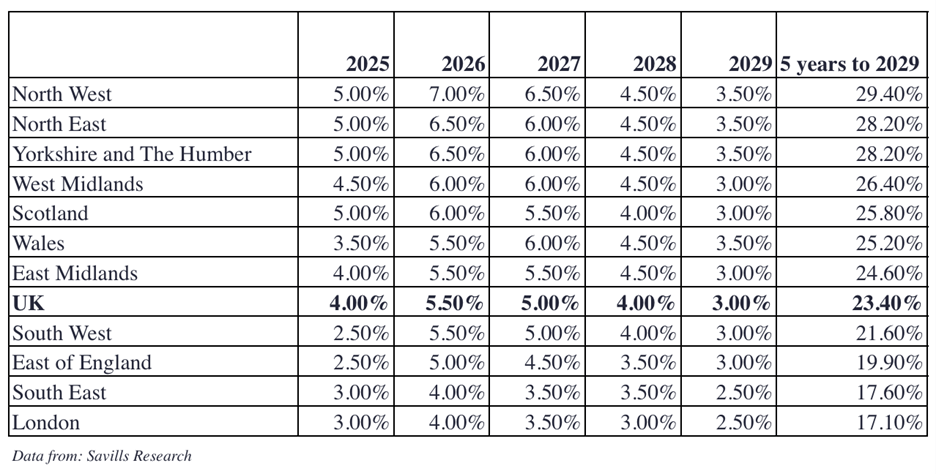According to the latest forecast from property advisor Savills, the average house price in the UK is poised for a significant increase of 23.4% over the next five years, translating to an anticipated rise of around £84,000. This positive outlook is bolstered by the stabilisation of inflation at the Bank of England’s target of 2%. With interest rates having been cut by a further 0.25% this week to 4.75%, the conditions are ripe for a sustained recovery in the housing market.
Savills projects a gradual increase in house prices, starting with a growth of 3.0% in 2024. This is expected to accelerate to 4.0% in 2025 and peak at 5.5% in 2026, before moderating to 5.0% in 2027, 4.0% in 2028, and finally 3.0% in 2029. This trajectory indicates a robust rebound in property values, as illustrated in the accompanying table.

With inflation stabilised, Savills anticipates a return to real house price growth of approximately 11% over the next five years. This projection is crucial, as nominal prices are currently about 2.3% lower than their peak in August 2022. In real terms, the decrease in house prices has been even more pronounced, reflecting a decline of approximately 10.5%. This context underscores the need for a recovery that not only addresses price growth but also restores buyer confidence.
Lucian Cook, head of residential research at Savills, emphasises that “with less external noise, house prices in the medium term will be dictated by the fundamentals of demand, supply, and affordability.” The landscape of mortgage rates has played a pivotal role in shaping buyer behaviour. As monthly mortgage costs decrease, buyer sentiment is improving, contributing to the moderate house price growth observed in recent months. However, the market remains sensitive to fluctuations in borrowing costs and potential changes in property taxation, which could create short-term disruptions.
In terms of market activity, a gradual recovery is anticipated, though it will not be uniform across all segments. The past couple of years have seen lower transaction levels largely due to elevated mortgage rates, particularly impacting home movers, who are typically more exposed to changes in borrowing costs. Transactions are expected to peak around 1,150,000 in 2028, yet this figure will likely remain below pre-pandemic levels, indicating a cautious recovery trajectory.
Savills identifies regional dynamics as crucial to this forecast. The North West is projected for the highest growth, expected to see a 29.4% increase by 2029, while London is forecasted to experience a more modest growth rate of 17.1%. These regional variations highlight the complex nature of the housing market, where affordability issues significantly influence buyer behaviour and market performance.

As the market progresses, some home movers may delay their decisions until interest rates stabilise, potentially around 2027. This pause may lead to increased activity among those looking to move up the property ladder in the latter half of the forecast period, driven by pent-up demand from previous high interest rates. Conversely, first-time buyers may continue to face challenges, particularly in the absence of supportive government mechanisms such as Help to Buy.
In summary, the outlook for the UK housing market is cautiously optimistic, with expectations of substantial price increases driven by improving economic conditions and stabilising inflation. However, the recovery will unfold at varying paces across different regions, highlighting the importance of understanding the unique dynamics influencing local markets.
(Source: Savills-news)